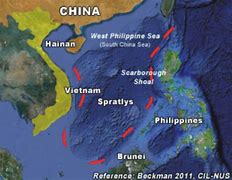Richard Sanders, Staff Writer
Phnom Penh
In the realm of international relations, territorial disputes often serve as contentious flashpoints that test the diplomatic acumen and resolve of nations. The Philippines, a Southeast Asian archipelago nation, finds itself embroiled in two such disputes with its neighbors, China and Malaysia. These disputes, while different in nature, reveal intriguing ironies and complexities in the Philippines’ stance on territorial integrity.
The Philippines-China territorial dispute primarily revolves around the South China Sea, a strategically vital waterway rich in natural resources and hotly contested by multiple countries, including China, Vietnam, Malaysia, and the Philippines. China’s expansive territorial claims, as delineated by the controversial Nine-Dash Line, encroach upon maritime territories that the Philippines considers its own, leading to heightened tensions and occasional confrontations between the two nations.
In contrast, the Philippines-Malaysia dispute centers on the status of Sabah, a resource-rich region located on the northern part of the island of Borneo. Historically, Sabah was under the influence of the Sultanate of Sulu, a once-powerful Muslim state in the southern Philippines. However, in the 19th century, Sabah was leased to the British North Borneo Company, eventually becoming a British colony. In a controversial move, the newly independent Federation of Malaysia annexed Sabah in 1963, leading to unresolved territorial claims by the Philippines.
The irony lies in the Philippines’ contrasting approaches to these two disputes. While vehemently asserting its sovereign rights in the face of China’s maritime assertiveness and refusing to cede an inch of territory in the South China Sea, the Philippine government’s stance on Sabah appears more ambiguous. Despite historical claims to Sabah, the Philippines has refrained from pursuing aggressive diplomatic or legal actions to reclaim the territory from Malaysia, opting instead for a more conciliatory approach.
The magnitude of the discrepancy between the two disputes is striking. Sabah encompasses over 70,000 square kilometers of land, a vast expanse compared to the minuscule slivers of territory at stake in the South China Sea. The Philippine government’s resolute stance against China’s encroachments in the South China Sea, juxtaposed with its relatively passive approach to the Sabah issue, raises questions about consistency, priorities, and national interests.
The complexities of these territorial disputes highlight the delicate balancing act that the Philippines must navigate in its foreign policy. Geopolitical considerations, historical legacies, economic interests, and strategic alliances all shape the calculus of territorial claims and the responses to them. As the Philippines grapples with the challenges posed by its territorial disputes, a nuanced and coherent approach that aligns with national interests and values remains essential.
The territorial disputes between the Philippines and China, as well as Malaysia, offer a glimpse into the multifaceted dynamics of international relations and the complexities of asserting sovereignty in a contested world. The ironies embedded in these disputes underscore the intricacies and contradictions inherent in statecraft, prompting a deeper reflection on the principles and priorities that guide a nation’s actions on the global stage.
